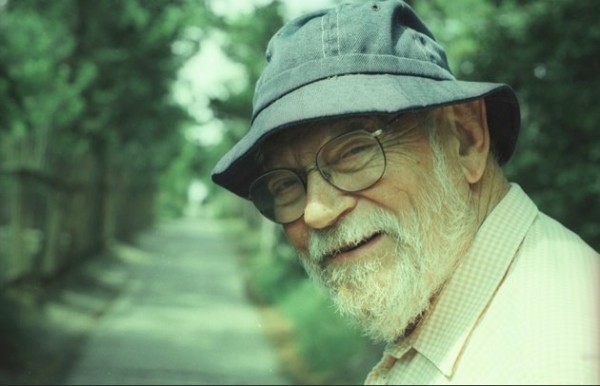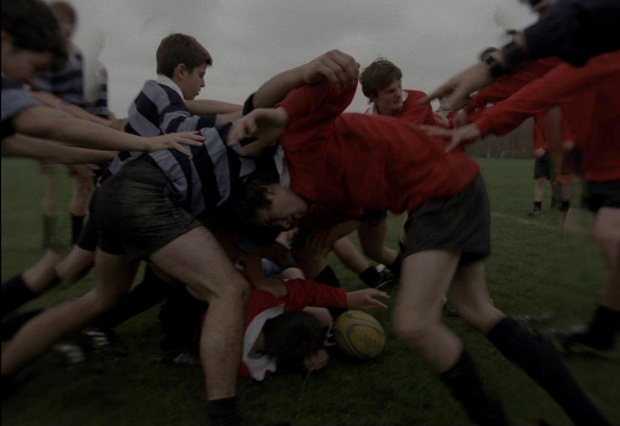Three Womens' Stories: An Interview with Michael Glawogger on Notebook | MUBI

DANIEL KASMAN: Did you always conceive this film in a three part structure?
MICHAEL GLAWOGGER: No. Like all of my films, I only know after the first filming. Once you have something you get a feeling for the whole project. Before that you want to look, you collect, you conceive things—but you don't know. I wrote a book this thick [indicates a big, fat book] for financing with many, many places I researched. There was Naples in it, there was Vienna, there was Nepal, and later on I went to Africa. But after the first sequence you know more what you're looking for. I knew when I filmed Bangladesh that I had done something quite...it was a manifesto, it was substantial, and I knew I couldn't break it down to 20 minutes, so I knew the film had to be something different. And the whole religion thing started to come up also in the research. So then I thought it should be like a Hieronymus Bosch painting, it should be like an alter; the only difference then was to have three different cultures, three different religions. And then I knew what I was looking for; I knew I wanted a left side, a beginning that is more lightweight, that is more glamorous, with Buddhism in a more easy-going surrounding, and I knew I wanted to end on something heavy, deep and Catholic.
...KASMAN: And what were the reactions of the Bangladeshi and Mexican audiences?
GLAWOGGER: In Bangladesh it was quite ethnographic in a way...almost two years had passed since the filming and they didn't realized the authenticity of image of themselves. One mother would see herself on the TV screen and she was a little, almost..."what is this?...What this woman here says is absolutely true and the whole world should hear it!" And then she'd reflect for a second and then realize "Oh, that's me!" It was very interesting in that sense, obviously while we filmed she was not aware of the outcome of what the project would be, but at the same time she was proud of what she said. In Mexico, also like in the movie, they are the most reflexive people, philosophical people. They would really watch the whole movie, they think Thailand is hell, they say "we pray we get to live in Mexico because we would never want to sit behind glass and not be able to communicate with our customers. How would we be able to know if we liked or disliked them?" They were very aggressive about Bangladesh, saying "what is this bullshit with the children there?" And all this without understanding the language because I only had English subtitles and they don't all speak English. Vana, the one who was so explicit about the rimming and the ice cubes and everything, she said "yeah it's great what I say there, but are my tits ok? I was a little ashamed but I think they're ok for my age, don't you think?" It was so human, it was very nice in that human sense, and we discussed the film for a long time. They really loved the music, the Mexican girls said "oh this song, I don't know her but she has a great voice, she's shouting out and we love that."
...KASMAN: What was it like interacting with the clients?
GLAWOGGER: Mainly, I wouldn't have thought it would have come up that much because I thought getting them to talk would be very difficult, but it came up by itself. Because I was going again and again and leaving the place and coming back trying to convince the girls, the regular customers came up to me and asked what the fuck I was doing. So I explained the movie and they cursed at me say "oh you journalists, you pissers, you always give us the red card and say we are the horrible guys and criminals and blah blah blah, are you one of them?" I said "come on, my film is a stage for these things, if you feel about prostitution and you have the balls and the guts to speak up, be my guest, I'm here." The moment that started I couldn't free myself from them! If they did not have a family or a job to lose they would all want to speak up. Sometimes they are stupid little kids, but I couldn't hate them, when I was nineteen I probably behaved like that too, in a way they were fun.
...KASMAN: I can imagine the entire pre-production of the film was fraught with negotiations. How difficult was it to shoot these private-public interactions, business being carried on, with a crew, you, cameraman, sound guy, how'd they let you do this?
GLAWOGGER: [laughing] I don't know! I think they got so tired, they just said "just do it, get the fuck outta here!" No, I mean, in a way it's easy too; as you can imagine most of these places are controlled by some kind of mafia. These are people, you can say they are criminals, on the other hand they are pretty straight-forward in their deals. The Mexican mafia demanded that they wanted to watch my films, so I came there with DVDs and they watched the movies, and they said "You did this in the film? What does it mean when you do this?" The funny thing about Mexico was that they said I could do anything but not to do drugs or sex in the film [the Mexican section in the final film includes both].
KASMAN: I take it you didn't show that part of the film to them.
GLAWOGGER: Oh yeah I did! They didn't care anymore, it was a straight deal, they wanted some money for it, they got it, and they stick to their thing.
...KASMAN: That's fascinating to me, because I would assume that due to the secrecy and shame involved in filming prostitutes and their stories, this subject would be one of the most difficult things to comprehensively film.
GLAWOGGER: It is difficult, but there's one thing I hate which is filmmakers who brag about the difficulty of their shooting, I really hate that with all my senses, so I'm not going to do it!
KASMAN: But between Workingman's Death and this, they're films that with almost every scene as an audience member you are aware of how the filmmaker had to get into the position to film what's on camera. We're conscious of that very difficulty.
GLAWOGGER: Otherwise I wouldn't stand with a short lens so close to them! I mean look at this American film that I think even got an Oscar, called Born into Brothels, which actually bullshits you because it beats around the bush all the time and the director sent children in to take pictures where she should actually film, so she's never there where the film has to be, but everyone thinks this is a charming idea when it's chicken shit, you know





 Diane Winston: "Part of why tv has become even more powerful as a place for working out social and cultural issues is that we are no longer isolated intelligences watching in our own homes. I'm struck by the number of blogs [or twitters] that work on issues around Dexter, around zombies or vampires, asking 'what does it mean to be human,' 'what is morality,' 'how does justice figure into love' 'how do i know what is spiritual,' 'can people change?' "
Diane Winston: "Part of why tv has become even more powerful as a place for working out social and cultural issues is that we are no longer isolated intelligences watching in our own homes. I'm struck by the number of blogs [or twitters] that work on issues around Dexter, around zombies or vampires, asking 'what does it mean to be human,' 'what is morality,' 'how does justice figure into love' 'how do i know what is spiritual,' 'can people change?' "






